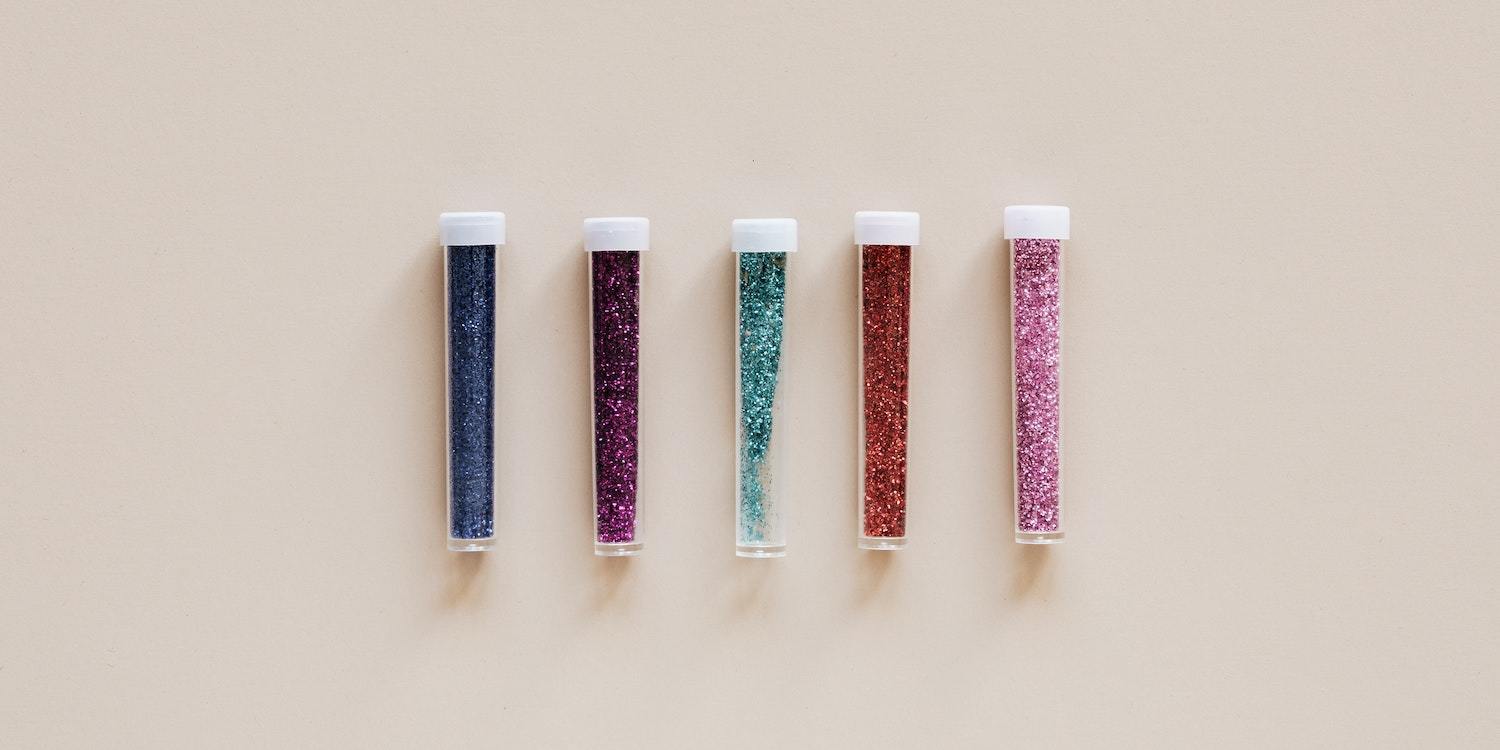As the month of December arrives, so do the holidays in all their sparkling glory. And with pitch-dark evenings and dropping temperatures, it’s no wonder the end-of-year festivities are hard to resist – the twinkling lights and sparkling Holiday cards really do brighten the winter months.
But all that glitter isn’t just magically whipped out of thin air. Each year, tons of manufactured sparkly plastic pours out of factories across the world, slowly making their way into our ecosystems.
And while the holidays often end up a glitter-fest, it’s not just your gift wrapping paper that’s covered in it. Cosmetic products, fashion, craft supplies… The list of things dusted in shimmers is long, and they are with us year-round.
You may have heard that glitter isn’t exactly eco-friendly. But how is glitter really made, and how does it actually affect the environment? And what about biodegradable alternatives – aren’t they a safe option?
Excellent questions. So today, we’re finding out exactly how sustainable glitter is – so you can make greener choices this holiday season, and in the coming year.
How Is Glitter Made?
Despite its popularity, glitter has only been around since the 1930s. It’s made from a mix of aluminum and either PET or PVC plastic – the aluminum coats the lightweight plastic core, creating the reflections we all know and love. Along with the preferred color, these materials are pressed into a long, ultra-thin sheet and then cut into tiny, sparkling pieces.
Sizes and shapes can vary – craft glitter is typically a little bigger, and cut into square or hexagonal shapes, while the ones made for beauty products typically come smaller and round, to minimize the scratch on your skin.
But generally, glitter ranges from about 0.05 to 6 mm in size – marking them firmly as microplastics
Ouch
How Does Glitter Affect the Environment?

So, why is glitter bad for the environment? Well, if you read our recent blog on microplastics, you’ll remember some of the ways these tiny pollutants wreak havoc on our ecosystems. Simply put – there’s no good way to dispose of glitter.
Since microplastics are too small to be caught by filtering mechanisms, there’s no way to stop them from ending up in our natural environments. And once there, they will long outlast us on this planet, because microplastics never actually biodegrade. They just break into smaller pieces until we can’t see them anymore.
And in the ocean, microplastics absorb toxins and chemicals – only to get eaten by fish and other animals. This can alter the animals’ hormone distribution, prompting changes in their natural behavior, and has led to stunted growth since they don’t actually get any nutrients. It can even damage internal organs and lead to death.
Of course, this doesn't just hurt the individual animals, but could potentially cause ripple effects through entire ecosystems. And with more than 51 trillion pieces estimated to be floating around the seas already, microplastics make up more than 11% of all plastics in the ocean – a number that is quickly on the rise.
Through fish, these plastics also enter our food chain. And while the effects of microplastics on humans are still mostly unknown, the various ways animals have responded to them doesn’t bode well.
More than 51 trillion pieces of microplastic are estimated to be floating around the seas already.
And it doesn’t end there, either. Studies have shown that glitter in the ocean reduces water quality, making plankton disappear and seagrass grow poorly – which, of course, isn’t exactly great for the fish or small organisms living there.
And just like that, glitter lost some of its sparkle.
Is Biodegradable Glitter Eco-friendly?
Of course, since the effects of microplastic have been brought to light in the last few years, many alternatives have started popping up. The most common one is so-called biodegradable glitter – also known as MRC. But how is biodegradable glitter made, and is it really eco-friendly?
MRC glitter is made by swapping out the plastic core for Modified Regenerated Cellulose, which is extracted from eucalyptus trees. Like with other glitters, the sheet is coated with aluminum to create reflection, but then, is still topped with a thin layer of plastic before being cut into tiny pieces.
Now, while these are supposedly entirely biodegradable, despite their plastic coating, a recent study that compared biodegradable and regular glitter showed that their impact on marine ecosystems are almost the same – and biodegradable glitter even caused a bigger flare in invasive snails.
So even though MRC glitter supposedly degrades, which would make it a better option than regular glitter, it’s not exactly eco-friendly.
A recent study that compared biodegradable and normal glitters showed that their impact on marine ecosystems are almost the same.
In good news, researchers at the University of Cambridge discovered a new way of making plant-based glitter just a few months ago. But it’s still in the early stages of testing and will take time before it can be ethically and sustainably made for all.
In other words – right now? An eco-friendly glitter isn’t really available on the market.
Eco-friendly Glitter Alternatives to Brighten Your Holidays
While this may be bad news, it doesn’t have to put a damper on your holidays – there are still fun ways to decorate for some Christmas cheer. After all, not all decorations have to sparkle.
Rather than decorate with glitter garlands or baubles, consider hanging up gingerbread cookies or dried orange slices. Rather than wrapping your gifts in glittering paper, try repurposing old newspapers or buying biodegradable paper instead.
All of these options are decorative, with the added benefit of being kind to the planet – and a creative way to get the family together. So, ask yourself: Do you really need glitter?
But if there’s that one little thing at the back of your mind, where just nothing but sparkles will cut it – we have you covered. And if you have kids, this one is sure to give them the crafty adventure they’re craving. Curious?
Well, here are two truly eco-friendly glitter alternatives: DIY colored sand or salt.
Both sand and salt crystals have a natural sparkle, and using either biodegradable food coloring or simply the juices from berries and fruits, you can color them easily at home. Simply put a few drops of color in a small bowl with salt or sand, mix well, and let it dry.
And voilá! An easy-to-make variant of glitter that won’t hurt the planet.
And there you have it! Hopefully, you learned a little bit more about glitter and its impact on our planet. Now, tell us: what is the best sustainable swap you’ve made for the holidays? Share it in the comments below!
Psst… Want to learn more? Check out our recent blog about ways to reduce microplastics in your life!






